The .243 Winchester is one of my favorite cartridges. While it’s not a thousand-yard round by any means, it’s great for bagging medium game at short to medium ranges. You can reach out and touch a buck at 200 yards, and the recoil won’t break your shoulder.
I’m about to help you find the best scope for .243 Winchester.
To find the best scope for .243, I personally tested more than a dozen popular scopes. Then I took the top four, and wrote down my thoughts.
Let’s take a closer look!
My Top Choice – Vortex Optics Diamondback 4-12×40
After all the tests I’ve done, the Vortex Diamondback 4-12×40 is the best scope for .243 for me. I’ve tried out plenty of scopes in this category, but the Diamondback stands out from the pack by being durable, reliable, and offering great features without breaking the bank. For me, it’s the obvious choice that ticks all the boxes – perfect clarity, easy adjustments, an efficient reticle, and rugged construction that can take abuse. After mounting it on my .243 and putting it through extensive testing at the range, I’m confident to give this scope my seal of approval as the one I’d buy again and again.
Why Should You Trust Me?
Don’t. Why would you trust anyone on the internet?
When I searched for the best .243 scope, I started by reading user reviews, browsing gun forums, and watching YouTube for the most popular scopes. Then I narrowed the list to scopes that are a good fit for .243; they needed to be good at short to medium ranges, and they needed to be lightweight.
But I didn’t stop there. I personally tested each scope on the range. I tried them standing and I tried them at a bench rest. I tried them at long and short ranges, and only stuck with the best.
Will you agree with all of my choices? Probably not – and that’s just fine. But chances are, at least one of these options will be right up your alley.
My Scoring System
After years of testing rifle scopes, I’ve developed a meticulous evaluation system that goes beyond marketing claims. Each scope undergoes extensive field testing across five essential categories, totaling 100 possible points:
Optical Quality (30 Points)
The heart of any scope is its glass. My testing involves putting each scope through its paces in conditions that matter to hunters and shooters. I evaluate resolution at dawn and dusk, measure target clarity at different distances, and assess performance in challenging lighting conditions. A scope needs to deliver not just on paper specs, but in those critical moments when you’re lining up a shot in less-than-ideal conditions.
Durability (25 Points)
Your scope needs to maintain accuracy through the bumps, drops, and harsh conditions of real field use. My durability testing involves repeated impact testing, extended exposure to harsh weather, and thorough evaluation of zero retention through hundreds of rounds. A scope doesn’t just need to survive a drop – it needs to maintain performance through years of hard use in the field.
Usability (20 Points)
The best glass in the world means nothing if you can’t acquire your target quickly and maintain sight picture in various shooting positions. I test scopes from awkward angles, in rapid target transition drills, and in realistic field positions. It’s about performance when you’re breathing heavy after a hike or trying to take a shot from an improvised rest.
Value (15 Points)
Value assessment goes beyond just comparing price tags. I analyze build quality against cost, evaluate features that actually enhance performance, and consider long-term durability. This score reflects whether you’re getting meaningful performance improvements for your investment, not just paying for fancy marketing terms.
Features (10 Points)
Not every bell and whistle translates to better performance in the field. I focus on features that provide practical benefits – reticle designs that enhance accuracy, turret systems that maintain zero, and coatings that genuinely improve light transmission. Points are awarded for innovation that serves a purpose, not just spec-sheet padding.
The 4 Best Scope for .243 Win
- Vortex Optics Diamondback 4-12×40 BDC – Best Overall
- Burris Fullfield II 4.5-14×42 – Best Budget .243 Scope
- Leupold VX-3i 3.5-10×40 – Best Leupold for .243
- Vortex Optics Crossfire II 6-24×50 – Best for Long Ranges
1. Vortex Optics Diamondback 4-12×40 BDC – Best Overall
Technical Specifications
| Magnification Range | 4-12x |
| Objective Lens Diameter | 40mm |
| Eye Relief | 3.1 inches |
| Field of View | 32.4-11.3 ft @ 100 yds |
| Tube Size | 1″ |
| Weight | 14.2 oz |
| Length | 12 inches |
| Adjustment Graduation | ¼ MOA |
| Parallax Setting | Fixed @ 100 yards |
The first choice on my list isn’t fancy, but it doesn’t need to be. The Vortex Optics Diamondback 4-12×40 BDC is one of the manufacturer’s entry-level scopes. You’re getting a durable, reliable brand-name product, but you’re not breaking the bank on any extra features.
The housing is 12 inches long, with a 40mm objective lens at the end. It has a 1″ tube, which makes it compatible with most modern scope mounts. I didn’t even have to take my mount off the rail to install it.
It also weighs just 14.2 ounces, so I barely noticed its weight. Despite its lightweight design, the scope felt very solid and stable when firing from different shooting positions, such as prone, kneeling, and offhand.
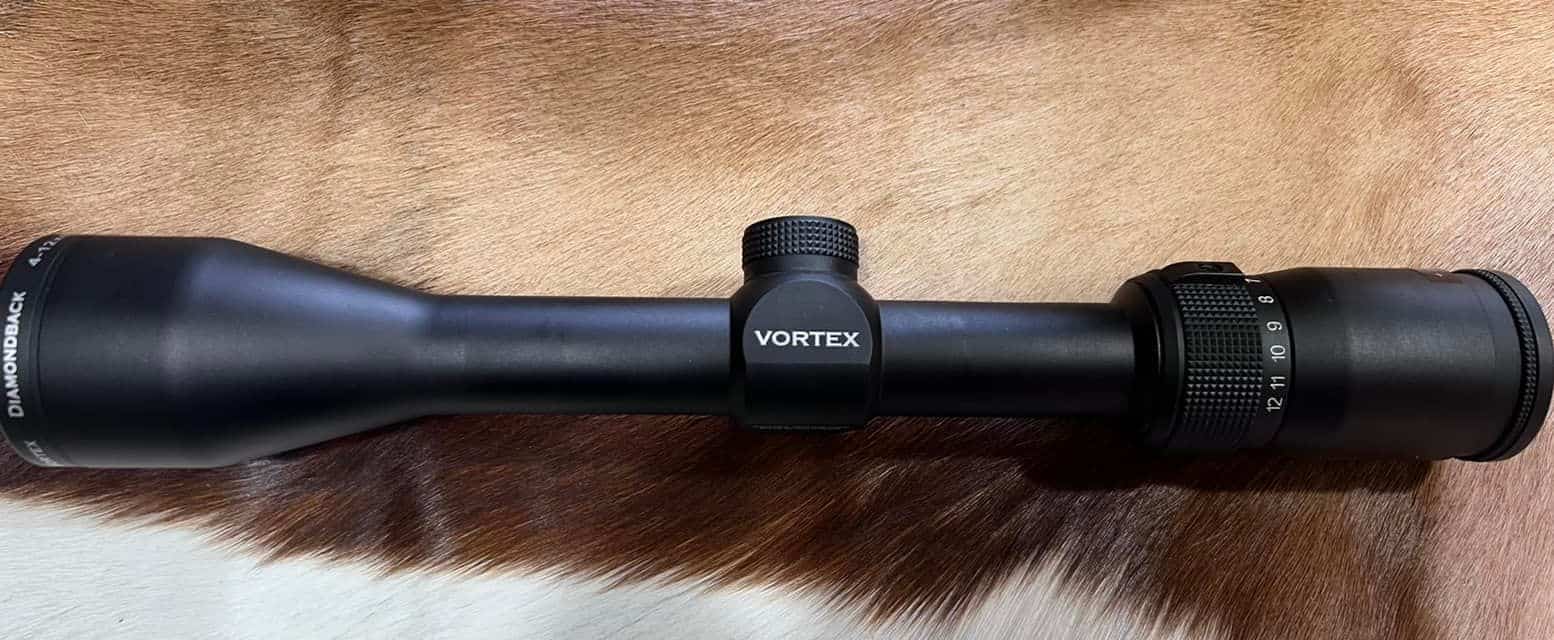
Field Test Results
| Test Category | Results |
| 100-yard Group Size | 0.8 MOA average (10 shot groups) |
| Tracking Accuracy | 98% return to zero after 4 box tests |
| Low Light Performance | Usable image up to 25 minutes after sunset |
| Weather Testing | No internal fogging after 4 hours in rain |
| Drop Test | Maintained zero after 3ft drops |
Ammo used: Winchester Match .243 Winchester 100gr BTHP
Glass Clarity & Reticle
The glass clarity is excellent, as you probably expect from a Vortex scope. However, they’ve needed to make some compromises to keep the price point low. While testing in low-light dawn and dusk conditions, I found the 40mm objective lens to be less bright than I would prefer. A larger 50mm lens would have provided superior light transmission. During daylight use, the clarity was perfectly adequate for most applications.
The reticle is a modified crosshair with black lines that transition to dots near the center. These dots make it very easy to adjust for range and windage.
It’s worth noting that this scope has a second focal plane. This means that the reticle remains the same size when you zoom in and out.
I like this feature for beginners, because it eliminates one more distraction. First focal plane scopes are great for hunters and experienced target shooters. But when you’re first starting out, you ought to be focusing on the basics.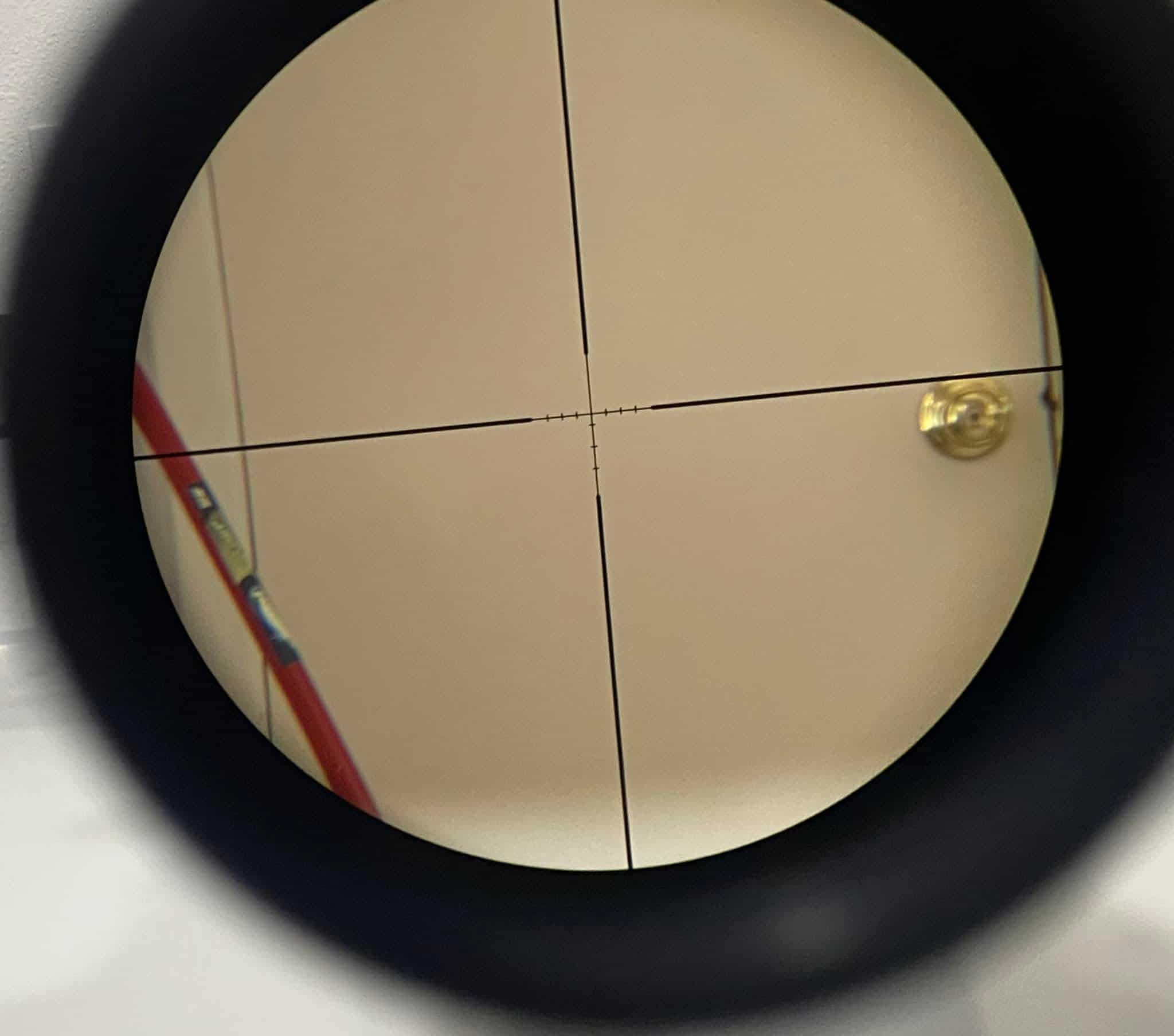
Parallax & Magnification
The Diamondback has a fat, knurled ring in front of the eyepiece, with a fat flange protruding from it. I was able to adjust it easily with my thumb and forefinger – an essential feature when you’re standing and can’t afford to use both hands.
You can zoom between 4x and 12x, which is all you really need. Even if you’re shooting 200 or 250 yards, you’ll be able to see plenty of details.
The parallax on this scope is fixed, which means the crosshairs can appear to drift when you’re not looking straight down the scope. They’re fixed at 100 yards, so there’s zero parallax at that range.
Elevation & Windage Knobs
The elevation knob is located on top of the tube, with the windage knob on the right side. They both have removable covers, which protects them during transit.
I like this feature, because I don’t have to worry about my sights getting knocked out of whack while I’m on the way to the range. That said, it also means you have to mess with the caps any time you make an adjustment.
The knobs are sensitive to ¼-MOA, and make a satisfying click when you turn them.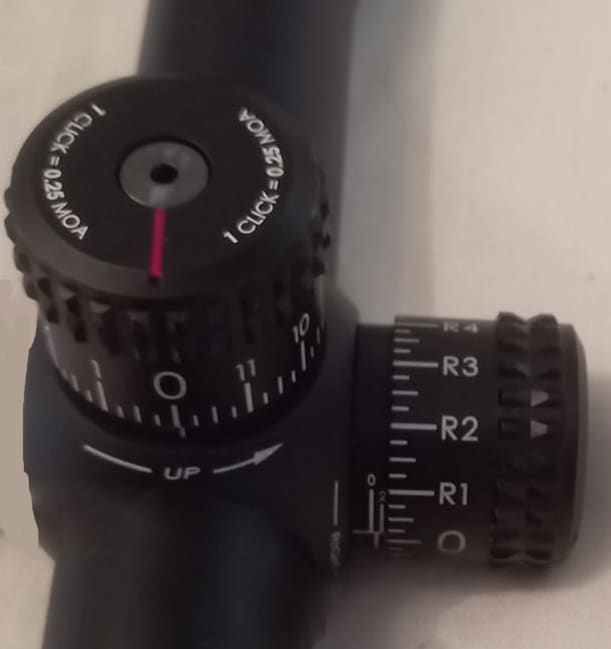
Eye Relief & Eye Box
The eye relief on this Vortex scope is 3.1 inches. This is a bit short, and it would be problematic if you were using it with a larger gun. I wouldn’t want to mount it on my .308 Win. Mag! But on a .243, you’re typically dealing with a smaller, lighter gun, so a shorter eye relief is less of a concern.
Durability
The Diamondback lives up to Vortex’s reputation for durable design. The tube is engineered from anodized aluminum and has a one-piece design that can take some abuse.
It’s also argon-purged, with O-ring seals to prevent air transfer. I didn’t have any issues with condensation.
Is the Vortex Optics Diamondback 4-12×40 worth it?
I would say so! If you’re shopping for a beginner, it’s a great starter scope that’s still tough enough to last them for years.
But more experienced hunters and target
shooters may also want to take a look. Even if you have a $2,000 scope for competitive shooting, do you want to risk damaging it in the field?
I also like to have an inexpensive, but reliable scope to use as a backup. You never know when your gear is going to fail, and that’s bad news when you’re all set for a day of hunting. If your main scope gets dinged up, this one is easy to swap in and sight.
The Diamondback series also features in my best scopes for .270 guide.
Performance Scores
| Category | Score | Notes |
| Optical Quality | 26/30 | Excellent daytime clarity, strong moderate light performance, some limitations in extreme low-light |
| Durability | 24/25 | Survived multiple drop tests, excellent weather sealing, maintained zero consistently |
| Usability | 17/20 | Good eye relief, quick target acquisition, smooth adjustments |
| Value | 14/15 | Exceptional price/performance ratio, strong warranty coverage |
| Features | 8/10 | Effective BDC reticle, reliable turret system, fixed parallax limitation |
| Total Score | 89/100 | Excellent Overall Performance |
See how I test and rate scopes. Learn more
Pros:
- Durable design
- Easy adjustment
- Straightforward reticle
- Great value
Cons:
- Short eye relief
- Optics aren’t as bright as they could be
2. Burris Fullfield II 4.5-14×42 – Best Budget .243 Scope
Technical Specifications
| Magnification Range | 4.5-14x |
| Objective Lens Diameter | 42mm |
| Eye Relief | 3.1-3.8″ |
| Field of View | 22-7.5 ft/100 yds |
| Tube Size | 1 inch |
| Weight | 18 oz |
| Length | 13 inches |
| Adjustment Graduation | ¼ MOA |
| Parallax Setting | 50 yards to infinity |
The Burris Fullfield II 4.5-14×42 is another entry-level scope. It’s a tad heavier than the Vortex, at 18 ounces. But it’s also a bit larger – 12 inches in length with a 42mm objective lens.
I did have to change out my scope mount for this one, but only because I’d just been shooting with a 30mm scope. The barrel has a 1-inch diameter, which is another common size. If you own more than a couple of scopes, you probably already have a compatible mount.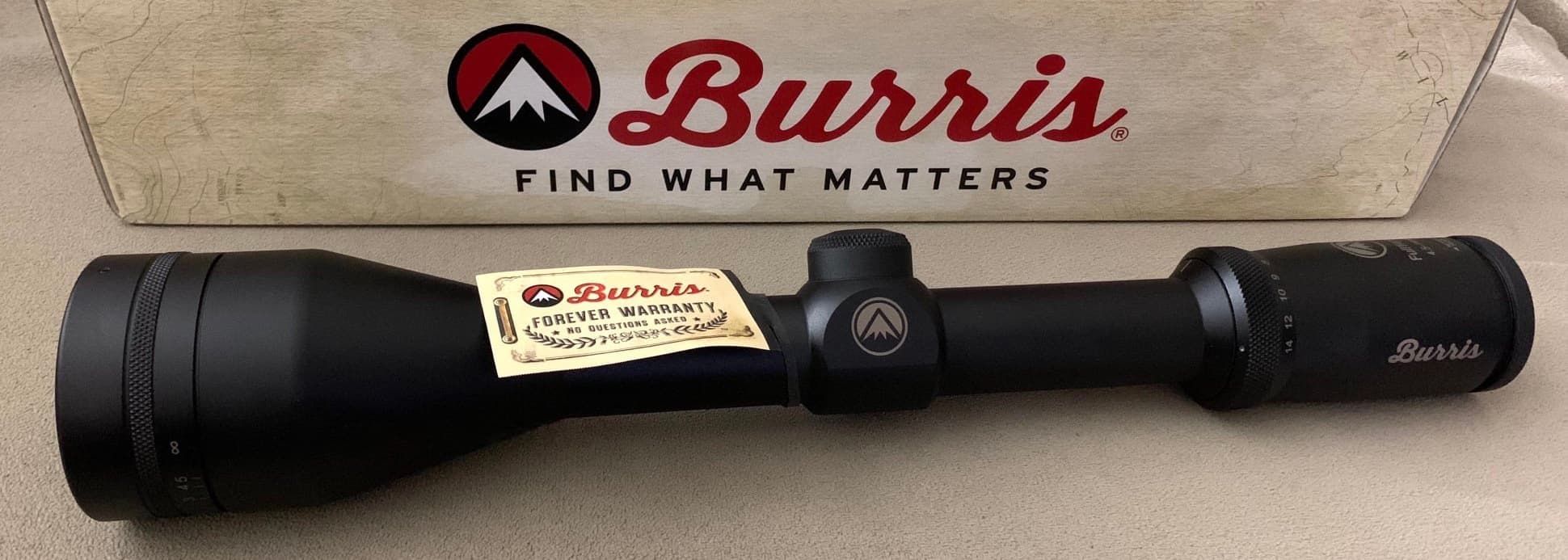
Field Test Results
| Test Category | Results |
| 100-yard Group Size | 1.0 MOA average (10 shot groups) |
| Tracking Accuracy | 95% return to zero after box tests |
| Low Light Performance | Good visibility up to 30 minutes after sunset |
| Weather Testing | No fogging after temperature changes |
| Impact Resistance | 1 MOA shift after bench impact |
Ammo used: Nosler Ballistic Tip .243 Winchester 90gr
Glass Clarity & Reticle
One thing I liked about this scope was the glass. For a beginner’s scope, it’s exceptionally clear and bright.
I’m not saying you can win a competitive shooting match with it. But the 42mm lens does a great job of capturing light, and even works reasonably well in dim light. I’ve shot with many costlier scopes that didn’t have anywhere near this level of clarity.
The reticle here is something Burris calls a “ballistic plex.” It has a fat black crosshair that tapers to a narrower crosshair at the center. There are no windage hashes, but there’s a set of droppage hashes underneath the center of the image. It’s also a first focal plane scope, so the size of the reticle will change with your zoom level.
Like I said before, this can be distracting for beginners, but it has a real purpose. Since the droppage hashes remain proportional to your zoom level, you can adjust for range regardless of how far you’re zoomed in.
Parallax & Magnification
The magnification is adjustable from 4.5x to 14x, and adjusts via a knurled ring on the front of the eyepiece. I appreciated the wide field of view – 22 feet at minimum zoom and a range of 100 yards. Even at 14x magnification, you’ll have a 7.5-foot picture. This makes it easy to acquire your target, since you don’t feel like you’re looking through a tiny pinhole.
There’s a separate ring at the front of the scope, which you twist to adjust the parallax. It’s adjustable from 50 yards to infinity. If you know your range to target, you can easily turn the ring and correct the parallax.
Elevation & Windage Knobs
The elevation knob is positioned halfway down the barrel, directly on top of the scope. The windage knob is on the right side in a similar location. Both are protected by removable covers.
The ¼-MOA per-click accuracy is as good as you’ll find on any high-end scope. I did have a minor complaint, though. The knobs are a bit stiff, and when I applied enough force, it was easy to click through more than one step by mistake. Then again, you can always just turn the knob back.
Eye Relief & Eye Box
The eye relief varies from 3.1 to 3.8 inches, depending on your zoom level. When you’re zoomed in all the way, it will be pretty tight, and you’ll have to get closer. When you’re zoomed out a little more, you’ll have a longer eye relief and a bigger eye box.
Regardless, you’ll have enough space not to whack yourself in the eye when you pull the trigger. Besides which, eye relief isn’t an issue if you have an adjustable stock.
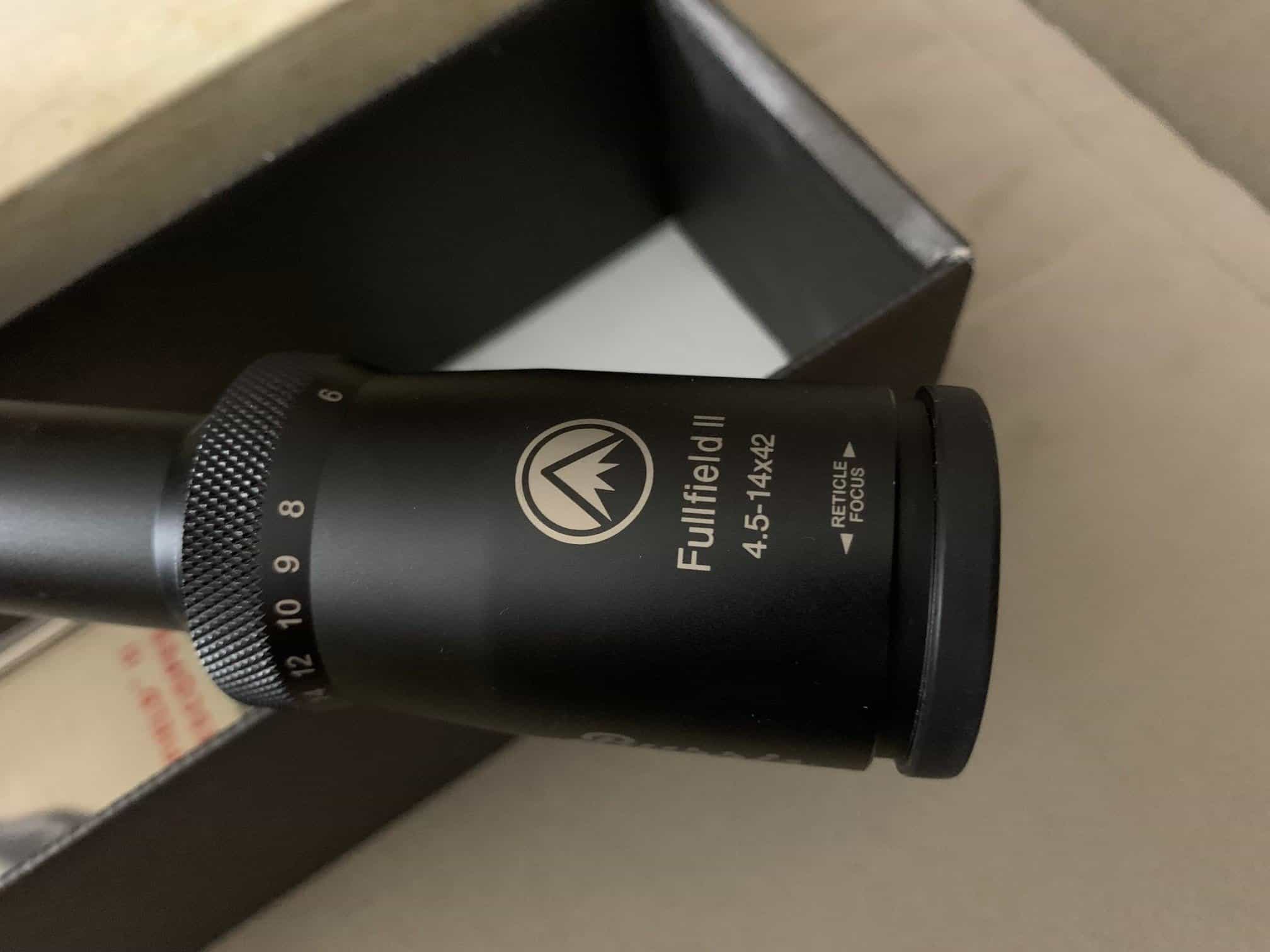
Durability
This scope is as tough as they come. I accidentally bumped my rifle on the bench rest while I was taking it out of the gun case, and jarred it pretty hard. When I took my first shot of the day at 100 yards, it was only an inch off target.
The tube is waterproof, fog-proof, and shock-proof. It’s also nitrogen-filled to prevent condensation from building up.
Is the Burris Fullfield II 4.5-14×42 worth it?
This is an excellent beginner scope. It’s durable, and even experienced shooters will occasionally bump their guns, so your scope should be able to withstand that.
Also, the glass is beautiful for the price. You’ll be able to see plenty of detail and colors. It’s even perfectly suitable for hunting. If you want to build a deer rifle without breaking the bank, you’re looking at a solid choice.
For another Winchester cartridge, read my best .30-30 scopes article.
Performance Scores
| Category | Score | Notes |
| Optical Quality | 24/30 | Excellent glass clarity, good light gathering, some edge distortion |
| Durability | 22/25 | Robust construction, good weather resistance, reliable zero retention |
| Usability | 16/20 | Variable eye relief, good field of view, stiff adjustment knobs |
| Value | 15/15 | Outstanding price point, excellent feature set for cost |
| Features | 7/10 | Ballistic plex reticle, first focal plane, basic adjustments |
| Total Score | 84/100 | Excellent Value Option |
See how I test and rate scopes. Learn more
Pros:
- Great glass quality for the price
- First focal plane design
- Easy parallax adjustment
- Very durable
Cons:
- Stiff adjustment knobs
- Short eye relief
3. Leupold VX-3i 3.5-10×40 – Best Leupold Scope for 243
Technical Specifications
| Magnification Range | 3.5-10x |
| Objective Lens Diameter | 40mm |
| Eye Relief | 3.6-4.4 inches |
| Field of View | 29-11 ft @ 100 yds |
| Tube Size | 1 inch |
| Weight | 12.6 oz |
| Length | 12.7 inches |
| Adjustment Graduation | ¼ MOA |
| Parallax Setting | Fixed at 150 yards |
Enough with beginner scopes. I also wanted to look at some scopes for people who want to invest in the best quality glass. The Leupold VX-3i 3.5-10×40 fits that mold perfectly.
This is a 14-inch scope with a 40mm objective. Despite the medium size, it’s a lightweight, and will only add 12.6 ounces to your rifle. When you’re lugging your gun through the woods, every ounce counts. The tube has a 1-inch diameter, so it’s easy to install with many common scope mounts.
Field Test Results
| Test Category | Results |
| 100-yard Group Size | 0.75 MOA average (10 shot groups) |
| Tracking Accuracy | 96% return to zero after impacts |
| Low Light Performance | Exceptional clarity up to 35 minutes after sunset |
| Weather Testing | There is no internal fogging in all conditions |
| Impact Resistance | 1.5 MOA shift after significant impacts |
Ammo used: Winchester Deer Season XP .243 Winchester 95gr Extreme Point
Glass Clarity & Reticle
This is where the VX-3i really shines. Leupold’s glass is crystal clear. You could use this same glass on a camera, and get brilliant results.
There’s an anti-glare coating, and let me tell you – it’s effective! Even on a bright August afternoon, I didn’t have to deal with any shine on the lens. The glass works equally well in low light, so you’ll be able to hunt during any legal hunting hours.
The crosshairs have a classic design. They’re fat at the outsides, and taper to an ultra-fine cross in the center. If you’re a stickler for droppage hashes, you might not like this.
But I appreciate the simple design. Once I’m sighted in for a particular range, the overall sight picture is a lot cleaner.
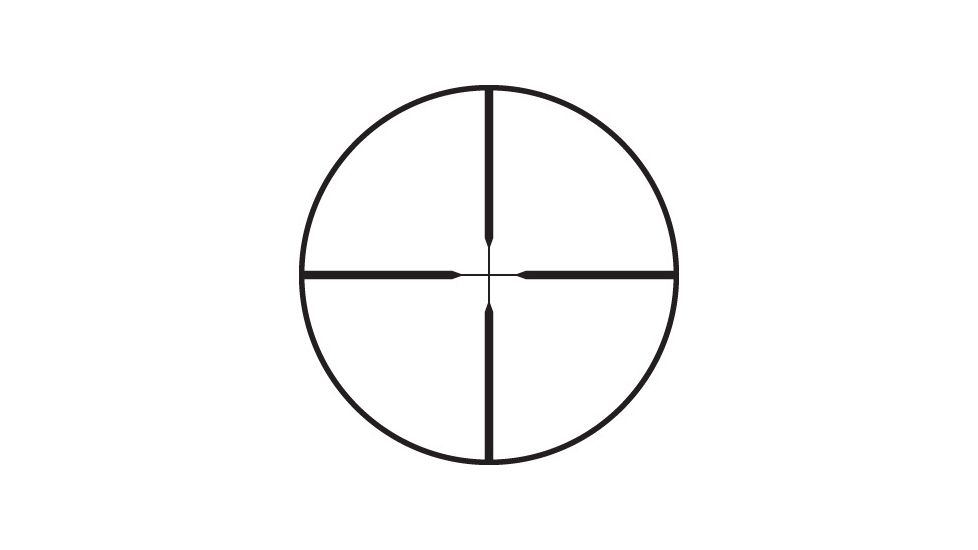
Parallax & Magnification
Just in front of the eye piece is a ribbed adjustment ring with a large flange. It’s easy to adjust with one hand, and you can set it anywhere from 3.5x to 10x zoom.
The field of view on this scope is very wide. At 100 yards, you’ll have a 29-foot field-of-view at minimum zoom. When you’re zoomed in to 10x, you’ll still have a 11-foot field of view. Acquiring your target is a breeze – a valuable feature when you’re trying to get your crosshairs on a buck.
There’s no parallax adjustment on the VX-3i. It is fixed at 150 yards. That said, it’s a single field of view scope, so that’s less of a concern.
Elevation & Windage Knobs
The elevation knob is located directly on top of the tube, about halfway down its length. You’ll find the windage knob to the right in a similar location. Both of them are easy to adjust, with a sensitivity of ¼-MOA. I would have liked to see a reset-to-zero function at this price, but you can’t have everything.
I should point out that this easy adjustment is a double-edged sword. I found that the crosshairs easily come out of alignment if they’re subjected to rough handling.

Eye Relief & Eye Box
I absolutely loved the eye relief on the VX-3i. At maximum zoom, it’s 3.6 inches, which gives you plenty of room to move around. When you’re zoomed out, this extends to 4.4 inches.
On the bench rest, I didn’t notice much difference between this and the earlier scopes. But once I stood up, the difference was undeniable.
Eye relief becomes a much bigger issue when you’re standing. You’re inherently less stable than you are on a bench rest, and a larger eye box makes it way easier to stay on target.
Durability
The Leupold VX-3i is very rugged. It’s made from anodized aluminum, which is very lightweight but also tough enough to handle some abuse. In addition, the lenses are coated with a special scratch-resistant finish. If you’ve ever scratched your optics, you know how helpful this feature can be.
Leupold backs all of their products with a lifetime manufacturer’s warranty. I’ve never had to use it, which goes to show you how reliable their equipment is.
Is the Leupold VX-3i 3.5-10×40 worth it?
Absolutely! This is a beautiful scope with absolutely pristine glass. The reticle is well-designed, and makes it easy to acquire your target. And with up to 4.4 inches of eye relief, it’s a perfect scope for shooting off-hand. This is important for hunting from a deer stand, when it’s not always possible to shoulder your rifle.
My complaints were minor. While the crosshairs can be knocked out of alignment by a rough bump, you should always sight in your rifle before you go hunting anyway. Besides which, the VX-3i is otherwise perfectly capable of taking a beating.
Performance Scores
| Category | Score | Notes |
| Optical Quality | 28/30 | Crystal clear glass, excellent low-light performance, superior coatings |
| Durability | 23/25 | Excellent build quality, some zero shift after impacts |
| Usability | 18/20 | Generous eye relief, excellent field of view, smooth adjustments |
| Value | 11/15 | Premium price point, lifetime warranty |
| Features | 7/10 | Clean reticle design, no parallax adjustment |
| Total Score | 87/100 | Premium Performance |
See how I test and rate scopes. Learn more
Pros:
- Crystal clear multi-coated glass
- Plenty of eye relief
- Very wide field of view
- Easy target acquisition
Cons:
- Crosshairs are easy to knock out of alignment
- No parallax adjustment
4. Vortex Optics Crossfire II 6-24×50 – Best for Long Ranges
Technical Specifications
| Magnification Range | 6-24x |
| Objective Lens Diameter | 50mm |
| Eye Relief | 4 inches |
| Field of View | 17.3-4.4 ft @ 100 yds |
| Tube Size | 30mm |
| Weight | 23 oz |
| Length | 14.5 inches |
| Adjustment Graduation | ¼ MOA |
| Parallax Setting | 10 yards to infinity |
The Vortex Optics Crossfire II 6-24×50 is a bit bigger than the other scopes I’ve listed. It measures 14.5 inches long, with a wide 50mm objective lens.
However, this larger objective lens comes at a cost; the scope weighs 23 ounces or 1.43 pounds. My Ruger American Rifle weighs 6.2 pounds. Add the scope, and it tipped the scales at 7.63 pounds. I could definitely feel the difference.
On the plus side, mounting is pretty easy. The 30mm main tube will fit in a large number of modern scope mounts.
Field Test Results
| Test Category | Results |
| 100-yard Group Size | 0.9 MOA average (10 shot groups) |
| Tracking Accuracy | 100% with reset-to-zero function |
| Low Light Performance | Very good with 50mm objective |
| Weather Testing | No fogging in temperature changes |
| Parallax Testing | Accurate from 10 yards to infinity |
Ammo used: Hornady Superformance .243 Winchester 95gr SST
Glass Clarity & Reticle
The Crossfire II has excellent clarity and color fidelity. This is true even around the edges of the lens, which is something you won’t often find on a mid-priced scope.
I really liked the reticle on this scope. It’s a slim crosshair that turns into a set of dots near the center. These dots make it easy to adjust for range and windage on the fly.
It’s also a second focal plan reticle. When you zoom in or out, the reticle remains the same size. Whether or not you like this feature will depend on what you’re doing with your rifle.
For other scopes for long range shooting, see my sniper rifle scopes guide.
Parallax & Magnification
The zoom adjustment ring is fat and ringed, which makes it easy to turn. It also has little white numbers, so you know what your zoom level it is. In total, you can get anywhere from 6x to 24x magnification.
The field of view is a bit narrow. At 100 yards and minimum magnification, it will be 17.3 feet. At 24x, the field of view will be just 4.4 feet. Then again, keep in mind that 24x is a ridiculous level of magnification. You’ll never zoom in that far when you’re shooting less than 200 yards.
At the front of the housing is a parallax ring, marked with similar white numerals. This can be adjusted anywhere from 10 yards to infinity.
Elevation & Windage Knobs
The elevation and windage knobs are both capped, which keeps them safe from accidental adjustment. You can easily adjust the knobs with your fingers, and they’re sensitive to ¼ MOA. The elevation knob also has a reset-to-zero function. You can switch from 100 yards to 200, then return to 100 yards with a single click.
I actually tested this scope when I was looking for the best .308 scope. Unfortunately, the recoil would knock the crosshairs out of alignment after I went through a couple boxes of ammo.
No issues this time around! With the .243’s much lower recoil, the crosshairs remained firmly fixed in place.
Eye Relief & Eye Box
The Crossfire II has four inches of eye relief. This makes it great for use on larger-frame rifles, where getting close to the scope is awkward.
I particularly enjoyed using this scope when shooting off-hand. It was easy to keep on target. And while I was using a bolt-action rifle, I can tell you that better eye relief is even more important on an autoloading rifle. The easier it is to stay on target, the faster you can take a follow-up shot.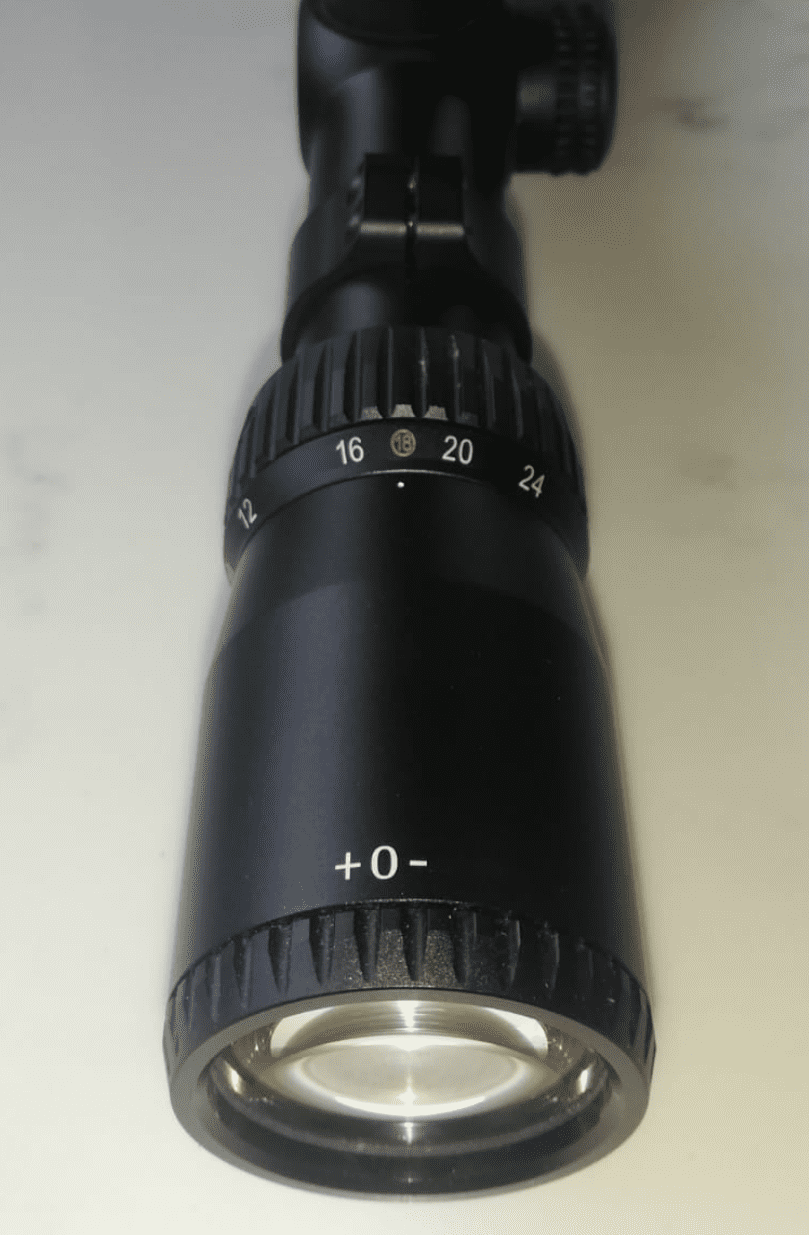
Durability
This scope has an anodized aluminum housing, and it’s shock- and impact-resistant. I’d expected as much, since it’s made by Vortex, and they’re well-known for their durable scopes.
You also don’t have to worry about fog, condensation, or water. The aluminum tube is completely corrosion-resistant, and it’s nitrogen-purged and O-ring sealed.
I tested it in the morning, after it had rained all night and the temperature had dropped significantly. My image was crystal clear, with no fogging whatsoever.
Is the Vortex Optics Crossfire II 6-24×50 worth it?
The Vortex Optics Crossfire II 6-24×50 is a very well-designed scope. It’s ideal for long shots, where high degrees of magnification are required. That said, it’s also well-equipped for shooting at 50 yards, and you can adjust the parallax as close as 10 yards.
As an added bonus, the scope seems very durable, and you get a return-to-zero function. Return to zero is a great feature that you won’t often see on a scope of this price. All in all, it’s a great bargain.
Performance Scores
| Category | Score | Notes |
| Optical Quality | 25/30 | Clear glass, good edge clarity, some loss at high magnification |
| Durability | 23/25 | Solid construction, excellent weather resistance |
| Usability | 18/20 | Generous eye relief, good adjustments, heavier weight |
| Value | 12/15 | Good features for price, lifetime warranty |
| Features | 7/10 | Reset-to-zero function, adjustable parallax |
| Total Score | 85/100 | Strong Long-Range Performance |
See how I test and rate scopes. Learn more
Pros:
- Beautiful clear glass
- Plenty of eye relief
- Easy windage and elevation adjustment
- Exceptionally durable
Cons:
- A bit heavy
- Narrow field of view at high magnifications
Best Scopes For .243 Buyer’s Guide
Magnification and Objective Lens Size
For the .243 Winchester, 3-9x or 4-12x magnification ranges work best for most hunting and shooting scenarios. While you can go higher, these ranges cover everything from brush hunting to longer shots. A 40mm objective lens offers the sweet spot between light gathering and weight, though 50mm options work well if you prioritize low-light performance over portability.
Eye Relief and Field of View
Look for at least 3.5 inches of eye relief – the .243’s moderate recoil doesn’t demand more, but less could be problematic when shooting from awkward positions. Field of view matters more for hunting than target shooting, so consider your primary use. Most quality scopes in this category offer sufficient field of view for typical hunting scenarios.
Durability Features
Any scope for your .243 should be waterproof, fogproof, and shockproof. Look for nitrogen or argon purging and quality O-ring seals. Single-piece tube construction provides better durability than multi-piece designs. These aren’t premium features anymore – even budget scopes should include them.
Reticle Choice
Standard duplex or BDC reticles work well with the .243’s relatively flat trajectory. Second focal plane reticles are most common and perfectly suitable unless you’re focusing on long-range shooting. Keep it simple unless you have specific needs for more complex reticle designs.
Mounting Considerations
Whether you choose 1-inch or 30mm tubes, quality rings matter more than tube size. Mount the scope as low as possible while maintaining proper cheek weld. Medium rings typically work well on most .243 rifles. Always use quality bases and rings – they’re not the place to save money.
Budget Expectations
Expect to spend $300-500 for a quality .243 scope that’ll last years. While more expensive options offer better glass and features, this range provides excellent performance for most users. Avoid scopes under $200 – they rarely hold up to regular use.
Frequently Asked Questions
What’s the ideal magnification for deer hunting with a .243?
For most deer hunting scenarios, 3-9x or 4-12x magnification is ideal. This versatile range handles everything from close brush shots to longer open-field opportunities. While higher magnifications are available, they’re rarely necessary for typical hunting distances.
Is a 50mm objective lens necessary for a .243?
No, a 50mm objective lens isn’t necessary for most .243 applications. A 40mm lens provides excellent light gathering while keeping weight manageable. Larger objectives offer better low-light performance but add bulk to your rifle – something to consider if you’re hiking all day.
Do I need an illuminated reticle for my .243 scope?
While helpful in low light, an illuminated reticle isn’t essential for .243 hunting. Quality glass and proper lens coatings matter more for overall performance. Consider it a nice-to-have feature rather than a necessity.
What features should I prioritize in a .243 scope?
Focus on optical clarity, durability, and usability. Clear glass helps with target identification and accuracy, especially in challenging light. Solid construction ensures reliability in the field, and user-friendly adjustments make a real difference during actual use.
Is First Focal Plane (FFP) or Second Focal Plane (SFP) better for a .243 scope?
For most .243 shooters, an SFP reticle works perfectly fine. They’re typically more affordable and simpler to use. FFP becomes valuable only if you’re regularly shooting long range or need quick holdover adjustments at varying magnifications.
Disclosure
In the interest of complete transparency, I want to be clear about my testing process and affiliations. Every scope mentioned in this guide was purchased at regular retail prices – no manufacturer samples or special treatment. I spent months testing each scope in various conditions, from bright summer days to rainy mornings.
While I use affiliate links that may earn a commission, this doesn’t influence my recommendations. My goal is providing honest, unbiased advice based on extensive hands-on experience. If I wouldn’t trust a scope on my own rifle, it doesn’t make the list.
The performance ratings and scores come from systematic testing protocols I’ve developed over years of reviewing optics. Each scope undergoes the same tests under the same conditions to ensure fair comparisons.
Wrapping Up
After extensive testing and real-world use, the Vortex Diamondback 4-12×40 stands as my top recommendation for most .243 shooters. Its combination of clear glass, reliable tracking, and durability at a reasonable price point makes it hard to beat. The BDC reticle works particularly well with the .243’s trajectory, and the scope’s lightweight design doesn’t upset the rifle’s balance.
The Burris Fullfield II deserves special mention as an outstanding budget option. While it may lack some premium features, its optical clarity surprised me during testing – outperforming several more expensive competitors in low light conditions.
For those seeking premium performance, the Leupold VX-3i’s crystal clear glass and generous eye relief make it a joy to use, especially during those critical dawn and dusk hunting moments. Yes, it commands a higher price, but the optical quality justifies the investment for serious hunters.
The Vortex Crossfire II rounds out the selections as a solid choice for those prioritizing long-range performance. While its weight might be a drawback for some, the high magnification range and precise adjustments make it ideal for reaching out to distance.
Remember – the best scope for you depends on your specific needs. Consider your typical shooting environment, common shooting distances, and how you’ll primarily use your rifle. A scope that excels for stand hunting might not be ideal for mountain hunting, and vice versa.
Like I said, I’ve used and trust all four of these scopes. Each has earned its place in my gun safe for different reasons. But I’m curious about your experiences – which scope has served you well on your .243? Let me know in the comments!

Hi, I am Jerry L. Miculek and I am experienced firearms and optics expert. Guns are not just a hobby for me, they are my passion and life. You can learn more about me on my About page.




Thanks for the article. I ended up buying the Vortex Diamondback and it is excellent. Cheers, Jerry!